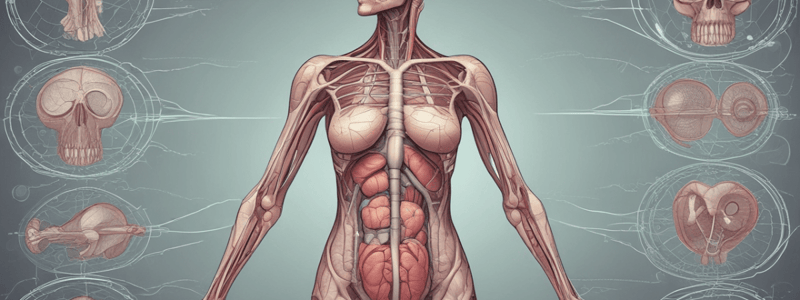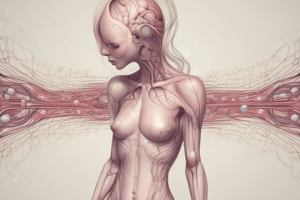Podcast
Questions and Answers
What is the function of the dartos and cremaster muscles in the male reproductive system?
What is the function of the dartos and cremaster muscles in the male reproductive system?
- To regulate the temperature of the testes (correct)
- To produce sperm
- To promote sperm production
- To eliminate germ cells
How many chromosomes are carried by a sperm cell?
How many chromosomes are carried by a sperm cell?
- 46
- 23 (correct)
- 50
- 20
What is the term for the failure of the testes to descend before birth?
What is the term for the failure of the testes to descend before birth?
- Androgens
- Cryptorchidism (correct)
- Sertoli Cells
- Spermatogenesis
What is the function of the Sertoli cells in the male reproductive system?
What is the function of the Sertoli cells in the male reproductive system?
What is the term for the process of producing sperm in the seminiferous tubules?
What is the term for the process of producing sperm in the seminiferous tubules?
What is the outer layer of the testes that is a serous membrane?
What is the outer layer of the testes that is a serous membrane?
What is the primary function of the mid-piece of a sperm cell?
What is the primary function of the mid-piece of a sperm cell?
How long does it take for sperm to move through the epididymis?
How long does it take for sperm to move through the epididymis?
What is the main function of the seminal vesicles?
What is the main function of the seminal vesicles?
What is the result of benign prostatic hyperplasia (BPH)?
What is the result of benign prostatic hyperplasia (BPH)?
Where do sperm exit the epididymis and continue their journey?
Where do sperm exit the epididymis and continue their journey?
What is the purpose of the fluid secreted by the prostate gland?
What is the purpose of the fluid secreted by the prostate gland?
What is the primary function of the bulbourethral glands in the male reproductive system?
What is the primary function of the bulbourethral glands in the male reproductive system?
What is the role of nitric oxide in the male reproductive system?
What is the role of nitric oxide in the male reproductive system?
What is the primary function of testosterone in the male reproductive system?
What is the primary function of testosterone in the male reproductive system?
What is the primary function of the ovaries in the female reproductive system?
What is the primary function of the ovaries in the female reproductive system?
What is the role of the corpus luteum in the female reproductive system?
What is the role of the corpus luteum in the female reproductive system?
What is the primary function of the uterine tubes in the female reproductive system?
What is the primary function of the uterine tubes in the female reproductive system?
What is the role of the stratum functionalis in the female reproductive system?
What is the role of the stratum functionalis in the female reproductive system?
What is the primary function of hormonal birth control?
What is the primary function of hormonal birth control?
What is the role of the SRY gene in the development of male and female?
What is the role of the SRY gene in the development of male and female?
What is the primary function of puberty in the development of male and female?
What is the primary function of puberty in the development of male and female?
Study Notes
Male Reproductive System
- A gamete is a specialized sex cell carrying 23 chromosomes, with sperm being the male gamete and oocyte being the female gamete.
- Testes produce sperm and androgens to support reproduction, located inside the scrotum to maintain a temperature 2-4 degrees cooler than body temperature.
- The testes have two layers: tunica vaginalis (outer layer) and tunica albuginea (tough connective tissue).
- Seminiferous tubules are where sperm develops, and they are tightly coiled and separated into 300-400 lobules.
- Sertoli cells promote sperm production and can eliminate germ cells, creating the blood-testis barrier due to tight junctions.
- Spermatogonia are stem cells or germ cells of the testes, and spermatogenesis is the process of producing sperm in the seminiferous tubules, which begins at puberty.
Structure of Sperm
- Sperm is smaller than most cells, with a volume 85,000 times less than a female gamete, producing 100-300 million sperm per day.
- The head of the sperm contains a haploid nucleus and little cytoplasm, covered in lysosomal enzymes in the acrosome.
- The mid-piece of the sperm contains tightly packed mitochondria.
- The tail of the sperm is a flagellum for movement or motility.
Sperm Travel
- Sperm travels from the seminiferous tubules to the epididymis, taking 12 days to move through the epididymis.
- The epididymis is a 6-meter-long, tightly coiled tube where sperm continues to mature.
- Sperm is stored in the tail of the epididymis until ejaculation occurs.
Male Reproductive Organs
- Seminal vesicles contribute 60% of semen volume, providing fructose for ATP.
- The prostate gland is a walnut-sized muscle and gland tissue that secretes fluid to coagulate semen.
- Bulbourethral glands contribute a thick, salty fluid to lubricate the end of the urethra and vagina.
Penis and Testosterone
- The penis has three chambers surrounding the urethra that fill with blood during arousal and REM sleep.
- Nitric oxide is released to dilate blood vessels and rapidly increase blood volume to fill the chambers.
- Testosterone is secreted by the 7th week of development to differentiate male sexual organs, increasing again at puberty.
Female Reproductive System
- The primary function of the female reproductive system is to produce gametes and hormones, as well as support and deliver a developing fetus.
- Ovaries are the female gonads, and oocytes are produced in the ovaries.
- The vulva includes external reproductive structures such as the labia minora, clitoris, hymen, and vagina.
Ovarian Cycle
- The ovarian cycle is approximately 28 days and has two interrelated processes: oogenesis (production of female gamete) and folliculogenesis (growth and development of follicles).
- The ovarian cycle consists of the follicular phase, ovulation, and the luteal phase.
Oogenesis
- Oogonia are ovarian stem cells that divide by mitosis, formed during fetal development.
- Primary oocytes halt development until puberty and last until menopause.
- Ovulation is the release of a mature oocyte from the ovary, which divides unequally with only one cell large enough to become a mature ovum.
Folliculogenesis
- Follicles grow and develop in the ovary, with only one dominant follicle surviving to release an oocyte.
- The process is regulated by GnRH, LH, and FSH hormones.
Menstrual Cycle
- The menstrual cycle is the shedding, rebuilding, and preparation of the uterine lining for implantation, consisting of three phases: menses, proliferative, and secretory.
- The timing starts with the first day of menses (day 1 of period).
Breasts and Hormonal Birth Control
- Breasts are accessory organs that supply milk to infants during lactation.
- Hormonal birth control works by manipulating the negative feedback system, providing constant hormones to prevent FSH and LH production.
Studying That Suits You
Use AI to generate personalized quizzes and flashcards to suit your learning preferences.
Related Documents
Description
Take this quiz to test your knowledge on the anatomy and physiology of the male reproductive system, including gametes, testes, and male gonads. Learn about the role of sperm, oocyte, and androgens in supporting reproduction. Get familiar with the structure and functions of the testes and its surrounding muscles.




